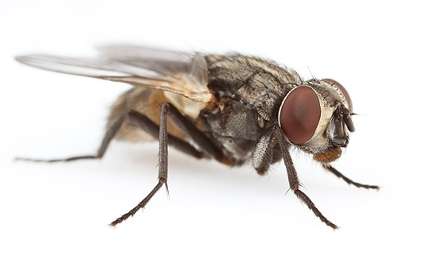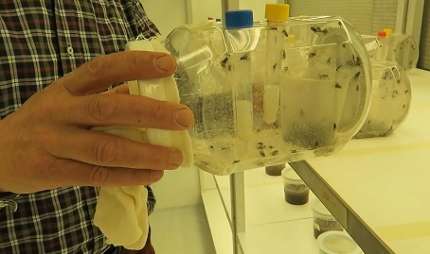What egg-producing housefly males can tell us about the evolution of sex determination

How do the two sexes come about? The answer to this question is more complex than one would expect. Though sexual reproduction invariably depends on the presence of male and female individuals, the genetic basis of sex determination varies strongly between species. This diversity is particularly evident in houseflies. This insect order provides an excellent model to study how different sex-determining mechanisms have evolved. Research groups in Zurich, Groningen and Göttingen now have important new findings to report in the prestigious scientific journal Science. They have identified the gene for maleness in houseflies.
In humans, females have two X chromosomes and males one X and one Y chromosome. The Y chromosome carries a gene that determines maleness. Houseflies are unique in using different ways of sex determination depending on where they live, in warm or cold climates.
Gene for maleness
In Northern Europe, sex determination in houseflies is similar to humans: females are XX and males XY. The Y chromosome carries the gene for maleness, but this gene is very different from the human one. In humans this is the SRY-gene that arose about 150 million years ago in the mammalian evolutionary lineage. The gene for maleness in houseflies, the M-factor, was unknown, but has now been identified by the authors of this study. This was possible by making elegant use of housefly genetics to produce same-sex progenies and search for genes which, at an early developmental stage, are active only in males. One candidate emerged from this screen which, when transiently inactivated during embryogenesis, produced males with fully differentiated eggs. A permanent disruption of the function of this gene caused complete sex transformation from males to sexually mature females
The newly found gene is baptized Mdmd, for Musca domestica male determiner. It is a large gene that strongly resembles another gene, called CWC22, which is present in all animals. Mdmd appears to have originated as a duplication of CWC22, after which it gained a specific role in sex determination. A hallmark of insect sex determination is that the messenger RNA of participating genes is spliced differently in females and males. CWC22 is a gene involved in regulation of this process, which is called alternative splicing. Therefore, it may not come as a surprise that a copy of this gene has evolved into a gene for male determination.
Translocation

Houseflies in Southern Europe do not have a Y chromosome with an M-factor. The gene for maleness is present on one of the other five chromosomes. Such a chromosome is called a proto-sex chromosome, because it very recently acquired a role in sex determination. This study shows that such novel sex chromosomes can originate by translocation of already existing male-determining genes, such as Mdmd, from the Y to another chromosome.
When this study began, no gene for maleness had been identified for any insect. In the meantime, a male-determining gene has been identified in two mosquito species, but the gene of the housefly has no similarity with the mosquito genes. This finding demonstrates that sex determination differs even between species of the same order and emphasizes how fast the genetic program for the development of females or males can change during evolution. We do not yet understand why there is so much variation in sex determination. This is a question to be addressed in future studies.
Zika
These studies are not just important for understanding the evolution of sex determination. More knowledge of the genetics of sex determination in the housefly can aid the design and development of novel, environmentally friendly control methods for pest insects. For instance, the Sterile Insect Technique (SIT) already benefits from a better understanding of sex determination. It has improved the production of sterile males on a large industrial scale. These sterile males, when released in excessive numbers into infested areas, will outcompete natural males and this will eventually lead to a collapse of the pest population. SIT has been successfully adopted for several species of agricultural pests and disease transmitting vectors. Hence long-term fundamental scientific research not only leads to a deeper understanding of biological phenomenons but this knowledge has also practical implications relevant to our society.
More information: Akash Sharma et al. Male sex in houseflies is determined by, a paralog of the generic splice factor gene, Science (2017). DOI: 10.1126/science.aam5498
Journal information: Science


















